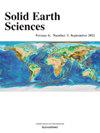Quantifying CO2 in apatite by multiple unpolarized transmission FTIR analyses
IF 2
4区 地球科学
Q3 GEOSCIENCES, MULTIDISCIPLINARY
引用次数: 0
Abstract
CO2 is a key volatile component in various fluids and magmas, and apatite is an ideal mineral for constraining the abundance, distribution and behavior of CO2 in different materials of the Solar System. In sharp contrast to water, CO2 in apatites has not been routinely investigated mainly due to lacking user-friendly analytical technique. Here we have developed a user-friendly analytical technique. By a Durango apatite crystal with a CO2 content of ∼277 (44) wt ppm, we performed 17 successful unpolarized transmission FTIR analyses on its randomly-selected fragments with unknown orientations. These analyses well reproduced the CO2 content, attaining a relative difference of ∼9 % only. Simple calculations carried out with this dataset suggest that as the number of the analyses increases from one, the accuracy of the result nonlinearly increases, being very fast at the first few analyses and much slower afterwards. Consequently, there are different minimum numbers of the analyses to meet different degrees of accuracy which may be required by different studies: it is highly unlikely to reach a result of any good by conducting one analysis only, but generally possible to arrive at a result with acceptable accuracy by performing two or three analyses, and almost certain to obtain a good result with high accuracy by collecting four or five analyses. If 10 or more analyses are possible, the accuracy of the result can be exceedingly high, with an absolute relative difference of < ∼10 %. With this user-friendly new method employing multiple unpolarized transmission FTIR analyses on randomly oriented crystals, quantifying CO2 in tiny apatite grains in different terrestrial and extraterrestrial materials can be readily actualized.
用多次非偏振透射FTIR分析定量磷灰石中的CO2
二氧化碳是各种流体和岩浆的关键挥发成分,而磷灰石是限制太阳系不同物质中二氧化碳丰度、分布和行为的理想矿物。与水形成鲜明对比的是,由于缺乏用户友好的分析技术,磷灰石中的二氧化碳尚未进行常规研究。在这里,我们开发了一种用户友好的分析技术。通过二氧化碳含量为~ 277 (44)wt ppm的杜兰戈磷灰石晶体,我们对其随机选择的未知取向碎片进行了17次成功的非偏振透射FTIR分析。这些分析很好地再现了CO2含量,获得的相对差异仅为~ 9%。用这个数据集进行的简单计算表明,随着分析次数的增加,结果的准确性非线性地增加,在最初的几次分析中非常快,然后慢得多。因此,不同的研究可能需要不同的最小分析数量来满足不同程度的准确性:仅进行一次分析是极不可能达到任何好的结果的,但通常可能通过进行两次或三次分析来获得具有可接受精度的结果,并且几乎可以肯定通过收集四次或五次分析来获得高精度的好结果。如果可以进行10次或更多的分析,则结果的准确性可能非常高,绝对相对差为<; ~ 10%。利用这种友好的新方法对随机取向晶体进行多次非偏振透射FTIR分析,可以很容易地实现不同地球和地外物质中微小磷灰石颗粒中CO2的定量。
本文章由计算机程序翻译,如有差异,请以英文原文为准。
求助全文
约1分钟内获得全文
求助全文
来源期刊

Solid Earth Sciences
GEOSCIENCES, MULTIDISCIPLINARY-
CiteScore
3.60
自引率
5.00%
发文量
20
审稿时长
103 days
 求助内容:
求助内容: 应助结果提醒方式:
应助结果提醒方式:


